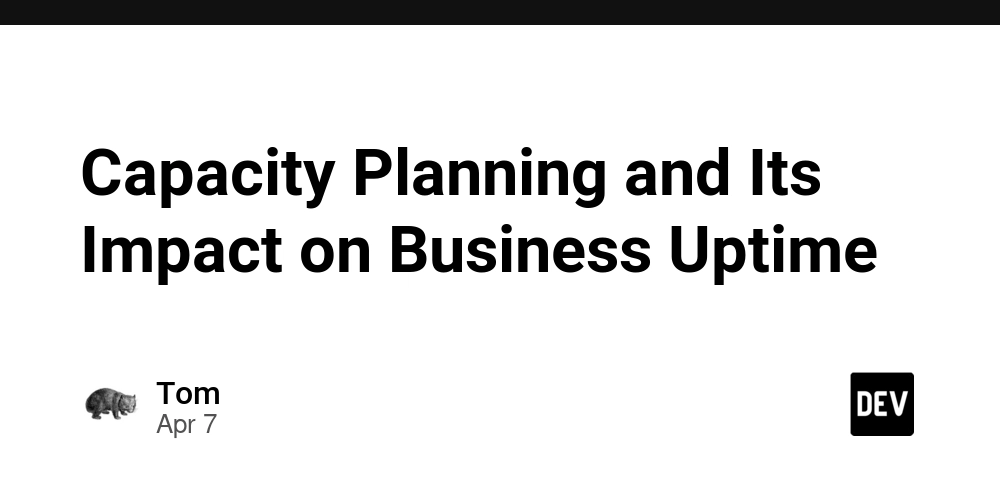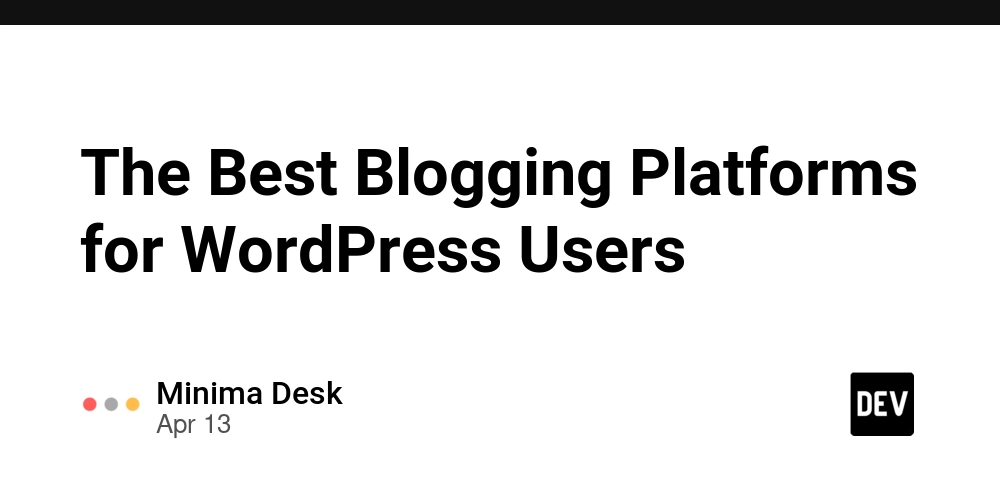Capacity Planning and Its Impact on Business Uptime
Proactive Capacity Planning: How to Keep Your Systems Running When Demand Spikes You've been there: Traffic suddenly quadruples. Your CPU graphs start climbing. Memory usage skyrockets. And every alert channel erupts in notifications. The dreaded capacity crunch. Whether it's Black Friday, a viral marketing campaign, or unexpected growth, inadequate IT needs prediction can turn success into disaster. Let's explore how proactive capacity planning can help you handle these moments with confidence instead of panic. Why Capacity Planning Matters More Than Ever Modern infrastructure is complex. A typical stack might include: Frontend → API Gateway → Microservices → Databases → Storage → CDN → Third-party APIs Each component has different scaling characteristics and breaking points. One overloaded service can bring down your entire system. A recent report by Splunk found that downtime costs Global 2000 companies a staggering $400 billion annually, with the average cost of downtime reaching $12.9 million per hour. In this environment, planning for uptime isn't just an IT concern—it's a business imperative. The Business Impact of Smart Capacity Planning Proactive capacity planning delivers tangible benefits across your organization: Revenue Protection When systems stay up during traffic spikes, you capture revenue when it matters most. One e-commerce site I worked with increased holiday season revenue by 32% after implementing proper capacity planning—not because they got more traffic, but because they could handle the traffic they already had. Improved User Experience Response times stay consistent even under load. Users get the same snappy experience whether you're serving 100 or 100,000 visitors. Reduced Operational Stress No more 3 AM firefighting when systems collapse under unexpected load. Your team gets to sleep, and your customers get to shop (or read, or stream, or whatever they do on your platform). Better Resource Utilization You spend money where it matters, scaling the right components at the right time rather than overprovisioning everything "just in case." Capacity Planning Strategies That Actually Work Different situations call for different approaches to IT needs prediction. Let's explore the main strategies and when to use them: 1. Lead Strategy: Building for Future Demand When to use it: For systems where downtime is extremely costly When scaling up quickly isn't possible For predictable seasonal spikes (like Black Friday) Real-world example: A streaming service preparing for a major show premiere might provision 200% of their estimated maximum capacity, knowing that a poor viewing experience would damage their brand significantly. Pros: Always ready for sudden traffic increases Provides confidence during high-stakes events Reduces stress on operations teams Cons: Higher ongoing infrastructure costs Resources sit idle during normal periods Requires accurate demand forecasting 2. Lag Strategy: Scaling After Demand Materializes When to use it: For non-critical systems When budget constraints are tight For services with highly unpredictable demand Real-world example: A SaaS startup might start with minimal infrastructure and add servers only when current resources reach 80% utilization, accepting some performance degradation during growth phases to keep costs down. Pros: Minimizes wasted resources Lower upfront costs Simpler forecasting requirements Cons: Risk of service degradation during scaling Potential for lost business during transition Can create customer frustration 3. Match Strategy: Incremental Scaling with Demand When to use it: For services with predictable, gradual growth When scaling can be done quickly and easily For systems with good monitoring and automation Real-world example: A content platform might expand its CDN capacity in 25% increments whenever utilization reaches 70%, maintaining a close alignment between resources and actual needs. Pros: Efficient resource utilization Balanced approach to cost vs. performance Works well with cloud infrastructure Cons: Requires vigilant monitoring Needs frequent adjustments Still risks temporary capacity shortfalls 4. Dynamic Strategy: Automated Real-time Scaling The most sophisticated approach to proactive capacity planning leverages auto-scaling and infrastructure-as-code to adjust resources in real time based on actual usage. When to use it: For cloud-native applications When demand is highly variable When you have strong DevOps capabilities Real-world example: A news site might automatically scale web servers based on current traffic, database replicas based on query load, and CDN capacity based on cache hit ratios—all without human intervention. Pros: Maximum efficiency of resources Handles unpredictable spikes gracefully Minimal human intervention needed Cons: Requires sophisticated

Proactive Capacity Planning: How to Keep Your Systems Running When Demand Spikes
You've been there: Traffic suddenly quadruples. Your CPU graphs start climbing. Memory usage skyrockets. And every alert channel erupts in notifications.
The dreaded capacity crunch.
Whether it's Black Friday, a viral marketing campaign, or unexpected growth, inadequate IT needs prediction can turn success into disaster. Let's explore how proactive capacity planning can help you handle these moments with confidence instead of panic.
Why Capacity Planning Matters More Than Ever
Modern infrastructure is complex. A typical stack might include:
Frontend → API Gateway → Microservices → Databases → Storage → CDN → Third-party APIs
Each component has different scaling characteristics and breaking points. One overloaded service can bring down your entire system.
A recent report by Splunk found that downtime costs Global 2000 companies a staggering $400 billion annually, with the average cost of downtime reaching $12.9 million per hour. In this environment, planning for uptime isn't just an IT concern—it's a business imperative.
The Business Impact of Smart Capacity Planning
Proactive capacity planning delivers tangible benefits across your organization:
Revenue Protection
When systems stay up during traffic spikes, you capture revenue when it matters most. One e-commerce site I worked with increased holiday season revenue by 32% after implementing proper capacity planning—not because they got more traffic, but because they could handle the traffic they already had.Improved User Experience
Response times stay consistent even under load. Users get the same snappy experience whether you're serving 100 or 100,000 visitors.Reduced Operational Stress
No more 3 AM firefighting when systems collapse under unexpected load. Your team gets to sleep, and your customers get to shop (or read, or stream, or whatever they do on your platform).Better Resource Utilization
You spend money where it matters, scaling the right components at the right time rather than overprovisioning everything "just in case."
Capacity Planning Strategies That Actually Work
Different situations call for different approaches to IT needs prediction. Let's explore the main strategies and when to use them:
1. Lead Strategy: Building for Future Demand
When to use it:
For systems where downtime is extremely costly
When scaling up quickly isn't possible
For predictable seasonal spikes (like Black Friday)
Real-world example:
A streaming service preparing for a major show premiere might provision 200% of their estimated maximum capacity, knowing that a poor viewing experience would damage their brand significantly.
Pros:
Always ready for sudden traffic increases
Provides confidence during high-stakes events
Reduces stress on operations teams
Cons:
Higher ongoing infrastructure costs
Resources sit idle during normal periods
Requires accurate demand forecasting
2. Lag Strategy: Scaling After Demand Materializes
When to use it:
For non-critical systems
When budget constraints are tight
For services with highly unpredictable demand
Real-world example:
A SaaS startup might start with minimal infrastructure and add servers only when current resources reach 80% utilization, accepting some performance degradation during growth phases to keep costs down.
Pros:
Minimizes wasted resources
Lower upfront costs
Simpler forecasting requirements
Cons:
Risk of service degradation during scaling
Potential for lost business during transition
Can create customer frustration
3. Match Strategy: Incremental Scaling with Demand
When to use it:
For services with predictable, gradual growth
When scaling can be done quickly and easily
For systems with good monitoring and automation
Real-world example:
A content platform might expand its CDN capacity in 25% increments whenever utilization reaches 70%, maintaining a close alignment between resources and actual needs.
Pros:
Efficient resource utilization
Balanced approach to cost vs. performance
Works well with cloud infrastructure
Cons:
Requires vigilant monitoring
Needs frequent adjustments
Still risks temporary capacity shortfalls
4. Dynamic Strategy: Automated Real-time Scaling
The most sophisticated approach to proactive capacity planning leverages auto-scaling and infrastructure-as-code to adjust resources in real time based on actual usage.
When to use it:
For cloud-native applications
When demand is highly variable
When you have strong DevOps capabilities
Real-world example:
A news site might automatically scale web servers based on current traffic, database replicas based on query load, and CDN capacity based on cache hit ratios—all without human intervention.
Pros:
Maximum efficiency of resources
Handles unpredictable spikes gracefully
Minimal human intervention needed
Cons:
Requires sophisticated monitoring and automation
Complex to set up correctly
Can lead to unexpected costs if misconfigured
Implementing Effective Capacity Planning: A Practical Guide
Let's break down the IT needs prediction process into actionable steps:
Step 1: Establish Your Baseline
Before you can plan for growth, you need to understand your current state:
Baseline Metrics to Collect:
- Peak and average requests per second
- Resource utilization (CPU, memory, disk I/O, network)
- Response times under various load conditions
- Current scaling limits and bottlenecks
- Historical traffic patterns
Tools like Prometheus, Grafana, or cloud provider monitoring solutions can help collect this data. The key is to gather enough historical information to see patterns and trends.
Step 2: Forecast Future Demand
Predict your future needs based on:
Historical growth patterns
Planned marketing initiatives
Seasonal fluctuations
Business projections
Remember that different components may grow at different rates. Your database might face more pressure than your web servers as user content accumulates.
Step 3: Identify Potential Bottlenecks
The weakest link in your architecture will limit your overall capacity. Common bottlenecks include:
Database connection limits
API rate limits (especially third-party services)
Network throughput
Stateful components that don't scale horizontally
Caching layers under pressure
For each component, calculate:
Current capacity
Scaling limits
Time needed to scale up
Cost of scaling
This analysis helps you prioritize your planning for uptime efforts.
Step 4: Define Scaling Triggers and Thresholds
Decide when and how to scale various components:
Example Scaling Triggers:
Web Servers:
- Scale UP when: CPU > 70% for 5 minutes
- Scale DOWN when: CPU < 30% for 15 minutes
Database:
- Scale UP when: Connection pool usage > 75%
- Scale DOWN when: Connection pool usage < 40% for 1 hour
Cache Layer:
- Scale UP when: Eviction rate > 100/second
- Scale DOWN when: Memory usage < 50% for 4 hours
These thresholds should be set conservatively at first and refined based on real-world performance.
Step 5: Implement and Test Your Scaling Plan
Proactive capacity planning is only theoretical until tested. Use load testing to verify your plans:
# Example load testing with k6
k6 run --vus 500 --duration 30m load-test.js
Ideally, test:
Normal operating conditions
Expected peak load
2x expected peak load
Sudden traffic spikes
Gradual traffic increases
Pay special attention to how your system behaves as it scales up. Does performance degrade gracefully, or do you hit sudden cliffs?
Step 6: Create Runbooks for Manual Interventions
Even with automation, you'll need human procedures for exceptional circumstances:
# Emergency Capacity Expansion Runbook
## Triggers
- Auto-scaling reaches 90% of configured maximum
- Response time exceeds 2 seconds for >10 minutes
- Error rate exceeds 0.5% for >5 minutes
## Actions
1. Increase auto-scaling maximum by 50%
2. Verify database connection pools can handle increased load
3. Alert customer service team of potential delays
4. Disable non-critical features if needed
5. Monitor error rates and response times
These runbooks should be clear enough that anyone on the on-call rotation can execute them under pressure.
Common Capacity Planning Pitfalls
Avoid these frequent mistakes in your IT needs prediction process:
Focusing Only on Server Resources
Applications can fail even when servers have plenty of capacity. Watch for:
Database connection limits
API rate limits
Software license restrictions
Network throughput
Ignoring Dependencies
Your system is only as scalable as its least scalable dependency. Map all internal and external dependencies and understand their scaling characteristics.
Planning for the Average, Not the Peak
Many capacity plans fail because they target average load rather than peak demand. Remember that a system at 50% average utilization might hit 95% during daily peaks.
Neglecting Non-Production Environments
Development and staging environments need capacity planning too, especially if you run performance tests there. I've seen companies where the staging environment became a bottleneck that delayed critical fixes.
Forgetting About Incident Response Capacity
During outages, you'll need extra capacity for debugging, increased logging, and recovery processes. Factor this into your planning.
Tools That Help With Capacity Planning
Several tools can support your proactive capacity planning efforts:
Monitoring Systems: Prometheus, Datadog, New Relic, Dynatrace
Load Testing Tools: k6, JMeter, Gatling, Locust
Forecasting Tools: Prophet, R Forecast, TensorFlow
Cloud Provider Tools: AWS Compute Optimizer, Google Cloud Capacity Planning
Uptime Monitoring: Bubobot, which helps identify performance trends before they become issues
The ROI of Good Capacity Planning
Investing in IT needs prediction delivers clear returns:
Avoided Downtime Costs: For a mid-sized e-commerce site, preventing just one hour of peak-time downtime can save $50,000+ in lost sales.
Reduced Infrastructure Costs: Better capacity utilization can cut cloud spending by 20-30% without sacrificing performance.
Improved Engineering Productivity: When teams spend less time fighting fires, they can focus on building features that drive business value.
Enhanced Customer Satisfaction: Consistent performance builds trust and encourages repeat business.
Conclusion: Capacity Planning Is Risk Management
At its core, proactive capacity planning is about managing risk. You're balancing the risk of underprovisioning (leading to downtime and lost revenue) against the risk of overprovisioning (leading to wasted resources and unnecessary costs).
The right approach depends on your business priorities, technical constraints, and risk tolerance. By following the steps outlined here, you can develop a capacity planning strategy that keeps your systems running smoothly—even when demand spikes unexpectedly.
Remember: The best capacity plans are living documents that evolve with your business and technology. Review and refine yours regularly to stay ahead of changing needs.
For a deeper dive into implementing effective capacity planning for your specific infrastructure, check out our comprehensive guide on the Bubobot blog.
ITNeeds #CapacityPlanningTips #ProactiveIT
Read more at https://bubobot.com/blog/capacity-planning-for-modern-infrastructure-ensuring-business-uptime?utm_source=dev.to











































































































































































![[The AI Show Episode 143]: ChatGPT Revenue Surge, New AGI Timelines, Amazon’s AI Agent, Claude for Education, Model Context Protocol & LLMs Pass the Turing Test](https://www.marketingaiinstitute.com/hubfs/ep%20143%20cover.png)


























































































































![[DEALS] Microsoft Visual Studio Professional 2022 + The Premium Learn to Code Certification Bundle (97% off) & Other Deals Up To 98% Off](https://www.javacodegeeks.com/wp-content/uploads/2012/12/jcg-logo.jpg)



![From Accountant to Data Engineer with Alyson La [Podcast #168]](https://cdn.hashnode.com/res/hashnode/image/upload/v1744420903260/fae4b593-d653-41eb-b70b-031591aa2f35.png?#)






































































































.png?#)





































































































































![What Google Messages features are rolling out [April 2025]](https://i0.wp.com/9to5google.com/wp-content/uploads/sites/4/2023/12/google-messages-name-cover.png?resize=1200%2C628&quality=82&strip=all&ssl=1)










![iPadOS 19 Will Be More Like macOS [Gurman]](https://www.iclarified.com/images/news/97001/97001/97001-640.jpg)
![Apple TV+ Summer Preview 2025 [Video]](https://www.iclarified.com/images/news/96999/96999/96999-640.jpg)
![Apple Watch SE 2 On Sale for Just $169.97 [Deal]](https://www.iclarified.com/images/news/96996/96996/96996-640.jpg)




































































































































